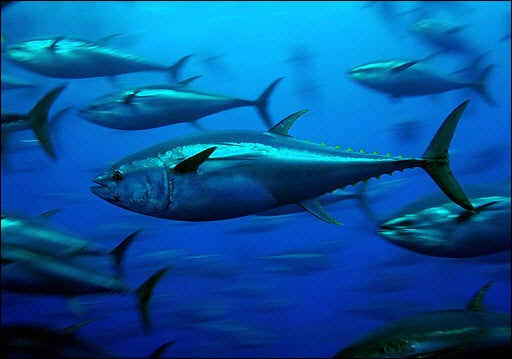Glimmers of Hope in the Global Effort to Save Bluefin Tuna
Recent developments in the Pacific, Atlantic, and Gulf of Mexico

This page was published 11 years ago. Find the latest on Earthjustice’s work.
Imagine meeting a 40-year-old fish that weighs 1,500 pounds and can accelerate faster than a sports car. Bluefin tuna are a top-of-the-food-chain fish and certainly one of the most impressive creatures in the ocean. Bluefin are also one of the most lucrative fish species to catch.
Buyers in the Japanese raw fish (sushi) markets set new records each year for the amount of cash they are willing to pay, and a worldwide fleet of fishers is eager to collect this cash.
In the Atlantic Ocean, bluefin tuna populations have collapsed throughout their historic range. Ranging from the Gulf of Mexico to the Mediterranean Sea, Atlantic bluefin tuna have declined by more than 70 percent in the Eastern Atlantic, and more than 80 percent in the Western Atlantic over the last 40 years.
With all this bad news, recent developments in the USA and internationally are providing a glimmer of hope for the imperiled bluefin tuna.
NOAA has developed new regulations to limit the use of surface longline fishing gear in critical bluefin spawning grounds in the Gulf of Mexico. The longline gear that fishers use to target swordfish and yellowfin tuna in the Gulf and the Atlantic employs thousands of baited hooks on a single line that stretches out miles behind the fishing boat. Bycatch is common wherever longlining is practiced, and the non-targeted fish is often thrown back into the sea, dead.
This amendment to its management plan for Highly Migratory Species will cover commercial fishing in the western Atlantic and the Gulf of Mexico, the bluefin tuna’s breeding ground. While not perfect, the new regulations contain a number of positive measures, like capping the number of bluefin that longline vessels can take as bycatch and requiring logline vessels to use video monitoring systems.
Join our friends at Pew Oceans, who are sending Thank You Notes to NOAA for doing the right thing for bluefin.
In the Pacific Ocean, a report released in 2014 found that Pacific bluefin tuna have declined to just 4 percent of their historical population. Even worse, almost all of the bluefin being caught today are juvenile fish that have not yet reproduced. Their numbers are so low that they have been considered for protection under the Endangered Species Act.
Pacific bluefin tuna spawn off the coast of China and travel as far as Mexico. They are fished at every stage of their lives across the entire ocean. Approximately 80 percent of Pacific tuna is sent to the sushi markets.
As the biggest consumer and fisher of bluefin tuna, in March 2014 Japan's Fisheries Agency announced it would cut its haul of Pacific immature bluefin tuna by 50 percent in 2015. At the Western and Central Pacific Fisheries this September, the other major catchers of tuna—South Korea, Taiwan, Canada and the United States—promised to follow Japan’s lead and cut their catch as well.
A final agreement is expected to be signed in December 2014.